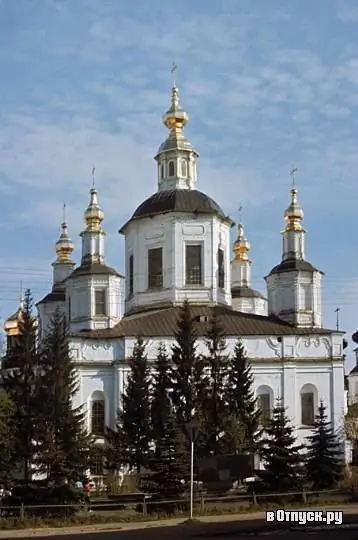
Description of the attraction
The Cathedral of the Assumption of the Mother of God rises majestically above the ancient cathedral square of Veliky Ustyug. The present cathedral was consecrated in 1658, but the church on this site was built in the XII-XIII centuries. Chronicles testify that in 1290 the bishop of Rostov came to Ustyug to consecrate a new church of the Assumption of the Virgin. However, it was not original, as the chronicle mentions. The construction of a stone temple is dated to the middle of the 16th century, on the site of the burnt down sixth temple made of wood. From the ancient wooden church, the cathedral inherited the static and centered composition, which were expressed in the calmly monumental form of a five-domed structure in the form of a cube, which has long become a canon for features of temples of this type.
For centuries, the cathedral enjoyed special privileges - the kings gave money for its decoration and reconstruction. The building was erected on the model of the Cathedral of the Assumption of the Moscow Kremlin. This temple is the first stone cathedral in the Russian North.
The appearance of the temple has changed for four and a half centuries. The majesty of the cathedral, the main part of which is monumental in its austere forms, is characteristic of the 16th century. From the south, the cathedral facade is closed by a two-storey warm Church of the Annunciation (XIX century). From the east, it is adjoined by a high two-part bell tower: a square one with a cube-shaped end and another, more complex in shape, with a spire (17th-18th centuries). Earlier on one of them there was a bell "Varlaam", about 17 tons (1054 pounds) in weight, cast in Ustyug.
The gilded carved iconostasis and stucco moldings are all that remain of the luxury of the 18th century cathedral interior. In 1780, Catherine II donated a large sum for its improvement. The interior of the cathedral is well decorated with stucco decorations: heads of angels, small sculptures, onlays, wreaths, cornices. The cathedral altar consists of three parts. The pillars and walls of the church, supporting the vaults, are surrounded by iconostases. The first iconostasis was completed by the 1670s. The reconstruction of the cathedral in 1731 - 1732 renewed the iconostasis and included ancient icons.
The icons of the tiers are placed in lush carved frames. The Royal Doors were decorated with sculptures of the Evangelists Matthew, John and Luke, made by Ustyug masters. The iconostasis that has come down to our time dates back to 1780. The iconostasis amazes with the uniqueness of the carving: flowers wrapped around columns with capitals, ornamental and openwork frames for the icons of the upper rows. Skilled craftsmen from Ustyug, Moscow, Yaroslavl took part in the creation of the interior.
The images of the iconostasis were painted by the priest of the cathedral, whose work introduced a new direction in Ustyug's icon painting. A contemporary noted that the city has the right to boast of its painting and icon-painting work, since it is under the supervision of the Cathedral Archpriest Vasily Alenev, who has equal dignity with the best Russian painters. Many wooden sculptures of the Savior were kept in the sacristy, the Gospel of 1689 was also there, in addition, there were many church utensils. In the cathedral were the shrines of Ustyug: the icon "Dormition of the Mother of God", the miraculous icons "Hodegetria" and "Annunciation".
The cathedral was closed in 1923. From 1929 to 1976, the building of the Cathedral of the Assumption was used as a warehouse. In 1930, the Assumption Cathedral was given over to a camp for the "disenfranchised". The restoration of the cathedral began in the last years of the twentieth century. In 1986, the domes of the cathedral were gilded. In 1988, the restoration of the bell tower was carried out. In 1997, a consecrated bell weighing 50 pounds (language - 40 kg) was raised to the bell tower of the Assumption Cathedral - a gift from a Moscow entrepreneur for the 850th anniversary of the city. Now Moscow craftsmen are restoring the unique iconostasis of the church and only external examination of the medieval monument is possible.
On August 27, 2008 in Veliky Ustyug, on the feast of the Dormition of the Mother of God, the rite of consecration of bells for the belfry of the cathedral took place. Today the bell tower has 10 bells. Visitors have access to the cathedral bell tower, from which there is a beautiful view of Veliky Ustyug.






